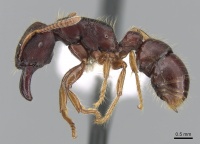Gnamptogenys stellae
| Gnamptogenys stellae | |
|---|---|

| |
| Scientific classification | |
| Kingdom: | Animalia |
| Phylum: | Arthropoda |
| Class: | Insecta |
| Order: | Hymenoptera |
| Family: | Formicidae |
| Subfamily: | Ectatomminae |
| Tribe: | Ectatommini |
| Genus: | Gnamptogenys |
| Species: | G. stellae |
| Binomial name | |
| Gnamptogenys stellae Lattke, 1995 | |
Nothing is known about the biology of Gnamptogenys stellae.
Identification
A member of the mordax subgroup (in the mordax species group). The median anterior projection of the clypeal lamella is unique among the extant species of the mordax group. This species seems to occupy an intermediate position between Gnamptogenys continua and Gnamptogenys horni. The combination of clypeal configuration, small eyes, subfalcate mandibles, glabrous occiput, mesometanotal suture and very brief petiolar peduncle point to this placement. (Lattke 1995)
Keys including this Species
Distribution
Latitudinal Distribution Pattern
Latitudinal Range: 10.35° to 9.4857096°.
| North Temperate |
North Subtropical |
Tropical | South Subtropical |
South Temperate |
- Source: AntMaps
Distribution based on Regional Taxon Lists
Neotropical Region: Colombia, Costa Rica (type locality).
Distribution based on AntMaps
Distribution based on AntWeb specimens
Check data from AntWeb
Countries Occupied
| Number of countries occupied by this species based on AntWiki Regional Taxon Lists. In general, fewer countries occupied indicates a narrower range, while more countries indicates a more widespread species. |

|
Estimated Abundance
| Relative abundance based on number of AntMaps records per species (this species within the purple bar). Fewer records (to the left) indicates a less abundant/encountered species while more records (to the right) indicates more abundant/encountered species. |

|
Biology
Castes
Nomenclature
The following information is derived from Barry Bolton's Online Catalogue of the Ants of the World.
- stellae. Gnamptogenys stellae Lattke, 1995: 183, figs. 60, 61 (w.) COSTA RICA.
- Type-material: holotype worker.
- Type-locality: Costa Rica: Estrella Valley, iv.1924 (W.M. Mann).
- Type-depository: USNM.
- Status as species: Lattke, et al. 2004: 348; Lattke, et al. 2007: 260 (in key); Lattke, et al. 2008: 97; Feitosa & Prada-Achiardi, 2019: 673; Camacho, et al. 2020: 458 (in key); Marcineiro & Lattke, 2020: 4 (in key); Camacho, Franco, Branstetter, et al. 2022: 11.
- Distribution: Colombia, Costa Rica.
Unless otherwise noted the text for the remainder of this section is reported from the publication that includes the original description.
Description
Worker
Holotype measurements: HL 1.18; ML 0.57; HW 1.06; SL 0.65; ED 0.13; WL 1.55 mm; CI 0.90; SI 0.61; OI 0.12.
Head elongate, in frontal view with concave vertexal margin, more or less parallel sided with eyes at about midlength; clypeal lamella gradually projects forward from sides and is medially weakly emarginate; mandibles almost linear and with a double row of low tubercles on apical border, dorsally and laterally smooth and shining with sparse punctae, basally with small area of longitudinal costulae; scapes smooth and shining, dorso-ventrally compressed, bent at basal one-fourth and thickest just apicad of mid length; cephalic dorsum with longitudinal striae, diverging posterad at vertex, gula mostly longitudinally striate, weakly di verging posterad; occipital margin glabrous.
Anterior pronotal face and collar with transverse striae; longitudinal striae on mesosomal dorsum and propodeal declivity, slightly shallower on metanotum and dorsal propodeal face; promesonotal suture very lightly impressed, metanotal groove markedly impressed and interrupting longitudinal striae. Mesosomal sides longitudinally striate, except for oblique striae on anepisternum; propodeal spiracle round and slightly raised above rest of integument; procoxae anteriorly and anterolaterally smooth and shining, posterolaterally striate; mesocoxae with dorsal transverse striae that are effaced posteriorly; metacoxae with transverse striae and low dorsobasal swelling; tibia and femora smooth and shining; anterior petiolar node face smooth and shining, laterally with weakly effaced longitudinal striae, dorsally diverging posterad; node wider posterad than anterad; petiole in lateral view slightly pedunculate, anteriorly slightly concave, dorsally slightly convex, posterior face dropping sharply; subpetiolar process anteriorly projecting with convex anterior border and posteriorly sinuous; gastric terga I and II with longitudinal striae, effaced towards posterior margin of tergum II. Gastric sterna I and II smooth and shining; pilosity sparse, a row of stout hairs present along apical mandibular order, few standing hairs on posterior cephalic dorsum, pronotum and gaster. Body reddish brown; mesosomal dorsum and head darker brown, leg and antennae ferruginous.
Type Material
Holotype worker. Costa Rica, Estrella Valley, April, 1924, W. M. Mann, leg. Deposited in National Museum of Natural History.
Etymology
The species epithet is derived from the Latin word for star, stella, and alludes to the type locality.
References
- Cantone S. 2018. Winged Ants, The queen. Dichotomous key to genera of winged female ants in the World. The Wings of Ants: morphological and systematic relationships (self-published).
- Lattke, J. E. 1995. Revision of the ant genus Gnamptogenys in the New World (Hymenoptera: Formicidae). J. Hym. Res. 4: 137-193 (page 183, figs. 60, 61 worker described)
- Lattke, J.E., Fernández, F. & Palacio, E.E. 2007. Identification of the species of Gnamptogenys Roger in the Americas (pp. 254-270). In Snelling, R.R., Fisher, B.L. & Ward, P.S. (eds). Advances in ant systematics: homage to E.O. Wilson – 50 years of contributions. Memoirs of the American Entomological Institute 80: 690 pp.
References based on Global Ant Biodiversity Informatics
- Fernández, F. and S. Sendoya. 2004. Lista de las hormigas neotropicales. Biota Colombiana Volume 5, Number 1.
- Longino J. T. L., and M. G. Branstetter. 2018. The truncated bell: an enigmatic but pervasive elevational diversity pattern in Middle American ants. Ecography 41: 1-12.
- Longino J. et al. ADMAC project. Accessed on March 24th 2017 at https://sites.google.com/site/admacsite/

